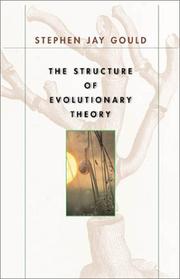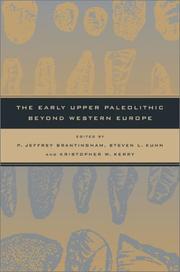| Listing 1 - 2 of 2 |
Sort by
|

ISBN: 0674417933 0674417925 9780674417922 0674006135 9780674006133 9780674417939 Year: 2002 Publisher: Cambridge, Mass.
Abstract | Keywords | Export | Availability | Bookmark
 Loading...
Loading...Choose an application
- Reference Manager
- EndNote
- RefWorks (Direct export to RefWorks)
The world’s most revered and eloquent interpreter of evolutionary ideas offers here a work of explanatory force unprecedented in our time—a landmark publication, both for its historical sweep and for its scientific vision. With characteristic attention to detail, Stephen Jay Gould first describes the content and discusses the history and origins of the three core commitments of classical Darwinism: that natural selection works on organisms, not genes or species; that it is almost exclusively the mechanism of adaptive evolutionary change; and that these changes are incremental, not drastic. Next, he examines the three critiques that currently challenge this classic Darwinian edifice: that selection operates on multiple levels, from the gene to the group; that evolution proceeds by a variety of mechanisms, not just natural selection; and that causes operating at broader scales, including catastrophes, have figured prominently in the course of evolution. Then, in a stunning tour de force that will likely stimulate discussion and debate for decades, Gould proposes his own system for integrating these classical commitments and contemporary critiques into a new structure of evolutionary thought. In 2001 the Library of Congress named Stephen Jay Gould one of America’s eighty-three Living Legends—people who embody the “quintessentially American ideal of individual creativity, conviction, dedication, and exuberance.” Each of these qualities finds full expression in this peerless work, the likes of which the scientific world has not seen—and may not see again—for well over a century.
Evolution (Biology) --- Punctuated equilibrium (Evolution) --- Equilibrium, Punctuated (Evolution) --- Punctuated equilibria (Evolution) --- Punctuationalism (Evolution) --- Animal evolution --- Animals --- Biological evolution --- Darwinism --- Evolutionary biology --- Evolutionary science --- Origin of species --- Biology --- Evolution --- Biological fitness --- Homoplasy --- Natural selection --- Phylogeny --- adaptation. --- anagenesis. --- competition. --- divergence. --- fossil record. --- genetics. --- germinal. --- hierarchical selection. --- homology. --- inheritance. --- lamarckism. --- mass extinction. --- micro v macroevolution. --- modern synthesis. --- neo darwinism. --- origin of species. --- paleontology. --- punctuated equilibrium. --- speciation. --- variation.

ISBN: 0520238516 9780520238510 0520930096 1282357166 1597345857 9786612357169 9780520930094 1417508132 9781417508136 6612357169 9781282357167 9781597345859 Year: 2004 Publisher: Berkeley : University of California Press,
Abstract | Keywords | Export | Availability | Bookmark
 Loading...
Loading...Choose an application
- Reference Manager
- EndNote
- RefWorks (Direct export to RefWorks)
This volume brings together prominent archaeologists working in areas outside Western Europe to discuss the most recent evidence for the origins of the early Upper Paleolithic and its relationship to the origin of modern humans. With a wealth of primary data from archaeological sites and regions that have never before been published and discussions of materials from difficult-to-find sources, the collection urges readers to reconsider the process of modern human behavioral origins. Archaeological evidence continues to play a critical role in debates over the origins of anatomically modern humans. The appearance of novel Upper Paleolithic technologies, new patterns of land use, expanded social networks, and the emergence of complex forms of symbolic communication point to a behavioral revolution beginning sometime around 45,000 years ago. Until recently, most of the available evidence for this revolution derived from Western European archaeological contexts that suggested an abrupt replacement of Mousterian Middle Paleolithic with Aurignacian Upper Paleolithic adaptations. In the absence of fossil association, the behavioral transition was thought to reflect the biological replacement of archaic hominid populations by intrusive modern humans. The contributors present new archaeological evidence that tells a very different story: The Middle-Upper Paleolithic transitions in areas as diverse as the Levant, Eastern-Central Europe, and Central and Eastern Asia are characterized both by substantial behavioral continuity over the period 45,000-25,000 years ago and by a mosaic-like pattern of shifting adaptations. Together these essays will enliven and enrich the discussion of the shift from archaic to modern behavioral adaptations. Contributors: O. Bar-Yosef, A. Belfer-Cohen, R. L. Bettinger, P. J. Brantingham, N. R. Coinman, A. P. Derevianko, R. G. Elston, J. R. Fox, X. Gao, J. M. Geneste, T. Goebel, E. Güleç, K. W. Kerry, L. Koulakovskaia, J. K. Kozlowski, S. L. Kuhn, Y. V. Kuzmin, D. B. Madsen, A. E. Marks, L. Meignen, T. Meshveliani, K. Monigal, P. E. Nehoroshev, J. W. Olsen, M. Otte, M. C. Stiner,J. Svoboda, A. Sytnik, D. Tseveendorj, L. B. Vishnyatsky
Paleolithic period --- Tools, Prehistoric --- Paléolithique --- Outils préhistoriques --- Europe, Eastern --- Asia, Central --- Europe de l'Est --- Asie Centrale --- Antiquities. --- Antiquités --- Eolithic period --- Old Stone age --- Palaeolithic period --- Stone age --- Implements, Prehistoric --- Implements, utensils, etc., Prehistoric --- Prehistoric implements --- Prehistoric tools --- Asia [Central ] --- Antiquities --- Europe [Eastern ] --- Tools [Prehistoric ] --- Asia [Central] --- adaptation. --- anthropology. --- antiquities. --- archaeology. --- aurignacian upper paleolithic. --- aurignacian. --- biological anthropology. --- blades. --- caucasus. --- central asia. --- china. --- danube. --- dzudzuana. --- eastern asia. --- eastern europe. --- evolution. --- fossil record. --- fossils. --- georgia. --- gobi desert. --- human behavior. --- interpleniglacial. --- karasu. --- koulichivka. --- levant. --- makarovo. --- modern humans. --- mongolia. --- mousterian middle paleolithic. --- nonfiction. --- paleolithic. --- prehistoric tools. --- russia. --- shuidonggou. --- siberia. --- ucagizh cave. --- upper paleolithic. --- wadi al hasa.
| Listing 1 - 2 of 2 |
Sort by
|

 Search
Search Feedback
Feedback About
About Help
Help News
News